Growing Summer Squash Vertically
This post may contain affiliate links, which means that I may receive a commission if you make a purchase using these links. As an Amazon Associate I earn from qualifying purchases.
Summer squash are among the easiest and most productive plants to grow in the garden. They are fun to grow too since there are so many different shapes, colors, and varieties. Often times I find myself trying to squeeze in more varieties than I have room for in the garden.
Summer squash loves the summer heat, and usually begins producing within 60 days after planting and continues all season until frost, disease, or squash vine borer takes it out.
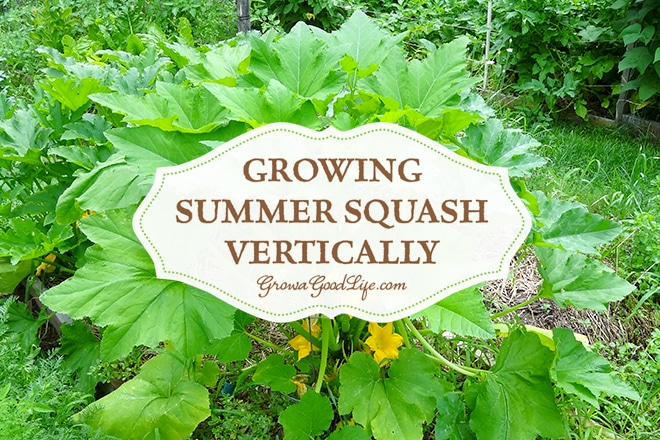
What is Summer Squash?
Squash is divided into two types, winter squash and summer squash. Summer squash differs from winter squash in that it is harvested young while it is still tender.
There are so many varieties of summer squash, including zucchini or courgette, patty pan or scallop, yellow crookneck, and yellow straight neck squash. Each type has many varieties, colors and shapes.
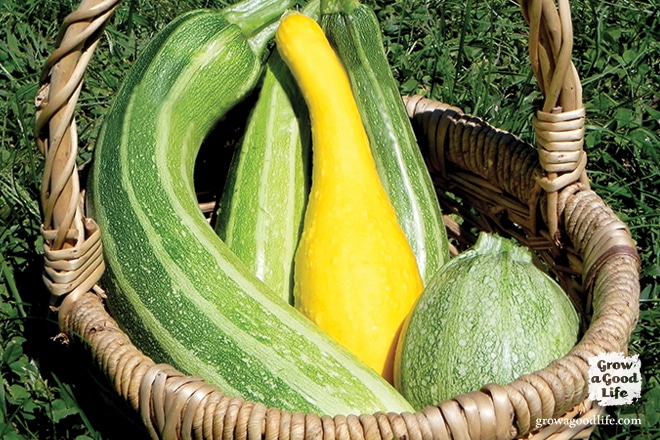
In contrast, winter squash has a thicker rind and is harvested in the fall, cured, stored, and consumed during the winter months. Common winter squash varieties include acorn, butternut, pumpkin, and spaghetti squash. Winter squash usually grows on long, rambling vines.
Most summer squash have a bushy growth habit. The fruit begins forming at the base of the stem and continues developing up the stalk as the plant grows. Even though summer squash plants are bush like, the stem of the plant does tend to lengthen a little as it grows.
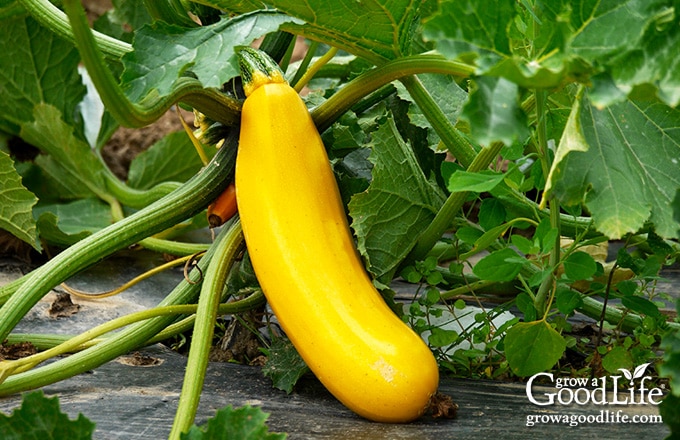
Since I have been converting my garden to permanent raised beds that are only 3-feet wide, I had to think of some creative ways to keep the summer squash confined to the bed and prevent it from flopping out into the aisles. For me, the logical answer was to grow summer squash vertically using tomato cages to support the plant and keep it upright.
Benefits of Growing Summer Squash and Zucchini Vertically
Although the reason I wanted to grow summer squash upright was to save space, I quickly discovered that growing summer squash and zucchini in tomato cages had other benefits as well.
- Growing summer squash vertically saves space. The plants can easily be trained to remain in the tomato cage as it grows. The cage provides support and keeps the plant upright, preventing it from flopping out of the growing bed into the walking paths.
- Growing zucchini upright encourages air movement. Good air circulation around the plant helps the foliage stay dry and averts downy mildew and other fungal diseases.
- Vertical growth keeps the squash off the ground. There is less chance of the fruit rotting from excess moisture since the squash is not touching the ground.
- It’s easier to see the zucchini to harvest. Growing upright allows the squash to be more visible reducing the chance of overgrowth. No more giant zucchinis!
- More light gets to the plant when growing upright. Zucchini and summer squash thrive in sun. Since the foliage is more spread out when growing upright, there is less shading allowing the plant to absorb more sunlight. Also, most pollinators prefer to forage in sun.
- Less places for squash bugs and other pests to hide. Squash bugs, cucumber beetles and other pests have less area to hide near the ground. Also, since the foliage is upright, it is easier to scout for and destroy eggs before they hatch.
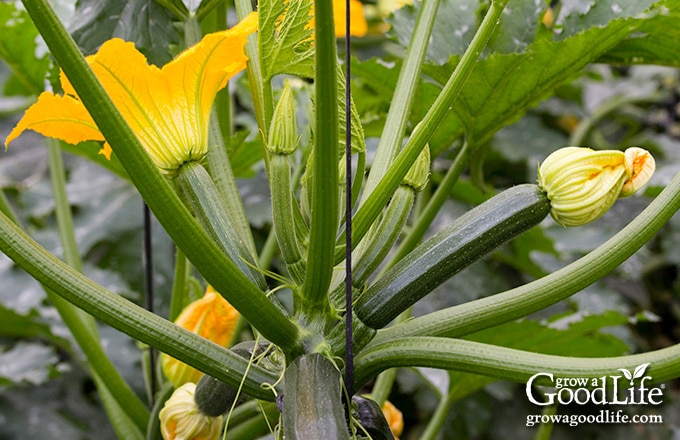
How to Grow Zucchini in Tomato Cage
Step 1: Plant the zucchini and summer squash. Either transplant seedlings or direct sow summer squash in a mound of soil.
Step 2: Add the tomato cage. Simply place a tomato cage securely in the ground when the zucchini and summer squash are young. Push the legs into the ground up to the first ring.
If you are using a flimsy tomato cage, hammer in a stake or long piece of rebar for extra support. Tie the tomato cage securely to the stake.
Step 3: Mulch the plants. Add organic mulch around the plants to help keep the weeds down, the roots cool, and conserve moisture. Keep the mulch a few inches away from the stem of the plant.
Step 4: Guide the zucchini and summer squash up. As the plant grows, gently direct the foliage and stem upward through the tomato cage. A few of the hollow stems do bend over the cage wires as the plant grows, but overall the benefits of growing summer squash vertically outweigh a few bent stems.

Growing summer squash vertically by trellising or in tomato cages helps to save space, encourages air circulation, and allows the squash to be more visible reducing the chance of overgrowth.
You May Also Like:
- 3 Easy Ways to Preserve Summer Squash
- Zucchini Garlic Bites Recipe
- DIY Self-Watering Containers
- How to Build a Square Food Garden
Good planning is key to a successful vegetable garden
Whether you are new to growing your own food or have been growing a vegetable garden for years, you will benefit from some planning each year. You will find everything you need to organize and plan your vegetable garden in my PDF eBook, Grow a Good Life Guide to Planning Your Vegetable Garden.
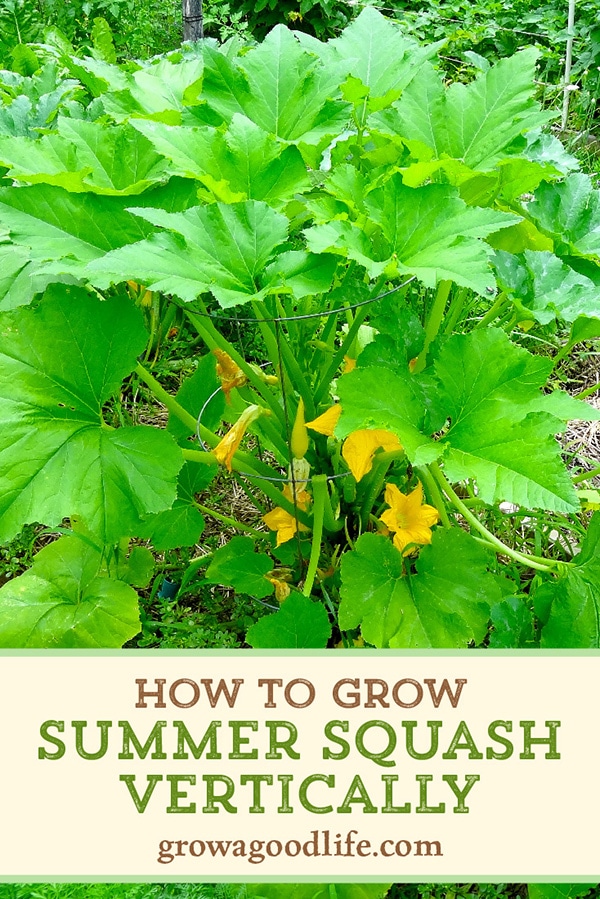


I planted yellow squash and zucchini squash and my yellow is blooming and make squash but the zucchini is not it jest blooming what can I do for that rickeyflanery@gmail let me no thanks
Rickey, Just be patient. Not all plants grow at the same rate. If your yellow squash is blooming, your zucchini will begin blooming soon.
The first blooms are not the ones that fruit typically. I believe those are the male ones. They bloom first. The female flowers will bloom after them.
Does this method allow more plants to be planted in a space? I have raised beds that are over 2ft tall… considering between this, or planting near the edges of the bed and allowing them to grow downward over the edge. We don’t have a ton of space but I want to grow a lot of different stuff!
Megan, Yes, it does save space to have your plants grow upwards instead of sprawling.
I’m trying this out this summer with my zucchini. Doing well so far. I have yellow squash next to the zucchini planted normally, and they are starting to flop into the path! May do all my summer squash vertically next year!
Awesome! Glad to hear it is working out for you.
This would work well for me. I grow my summer squash in pots to save my limited bed space. By the end of the season they grow over the edge and onto the deck where critters can get to them. Thanks for repeating the tip. I missed it first time around. – Margy
Hi thanks for this – I have tons of squash growing and they’re tightly packed – I think I’m going to build a trellis of some kind as they’re fighting for space now!
Will this work with cucumbers of honeydew melons? I live in Southwest Nova Scotia, and we get lots of wind!!!
Erin, Cucumbers and melons have much longer vines. You can grow these on a trellis with some support for the melons.
This is my first year gardening. Would it be possible to grow squash vertically using a trellis, or does it need to be surrounded on all sides? Looking at your picture, I’m starting to worry that I’ve over-planted my 3×6′ garden.
Megan, What type of squash are you growing? If your squash is a bush variety squash, trellising with tomato cages will keep it more compact. If you are growing a winter squash, you can grow it on a trellis by weaving the young vines through the trellis as it grows. The fruit will need to be supported. Panty hose works well for making a sling for the heavy fruit and allow rainwater to drain away.
Thank you!
I’m trying this, this year and I’m curious if you forced the leaves to stay inside the cage?
Hi Linda, I do try to direct the young leaves into the cage when I see them, but some grow outside. That’s ok as long as you have some inside to help support the growing vine inside the cage.
Do you use regular 42″ tomato cages or do you use extra large cages?
Danielle, The extra large heavy cages are what I use. I push them in almost to the first ring.